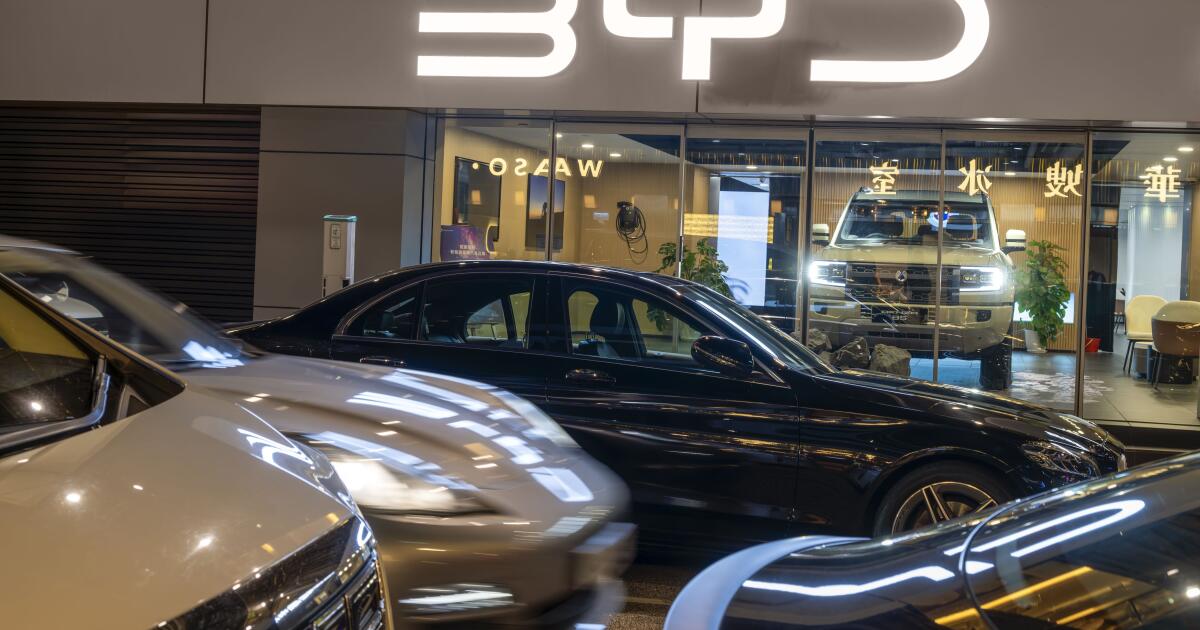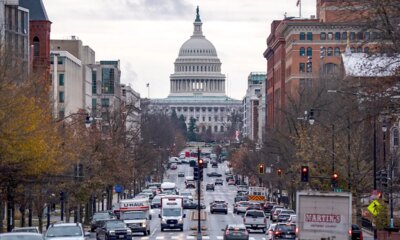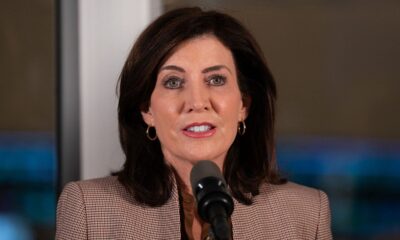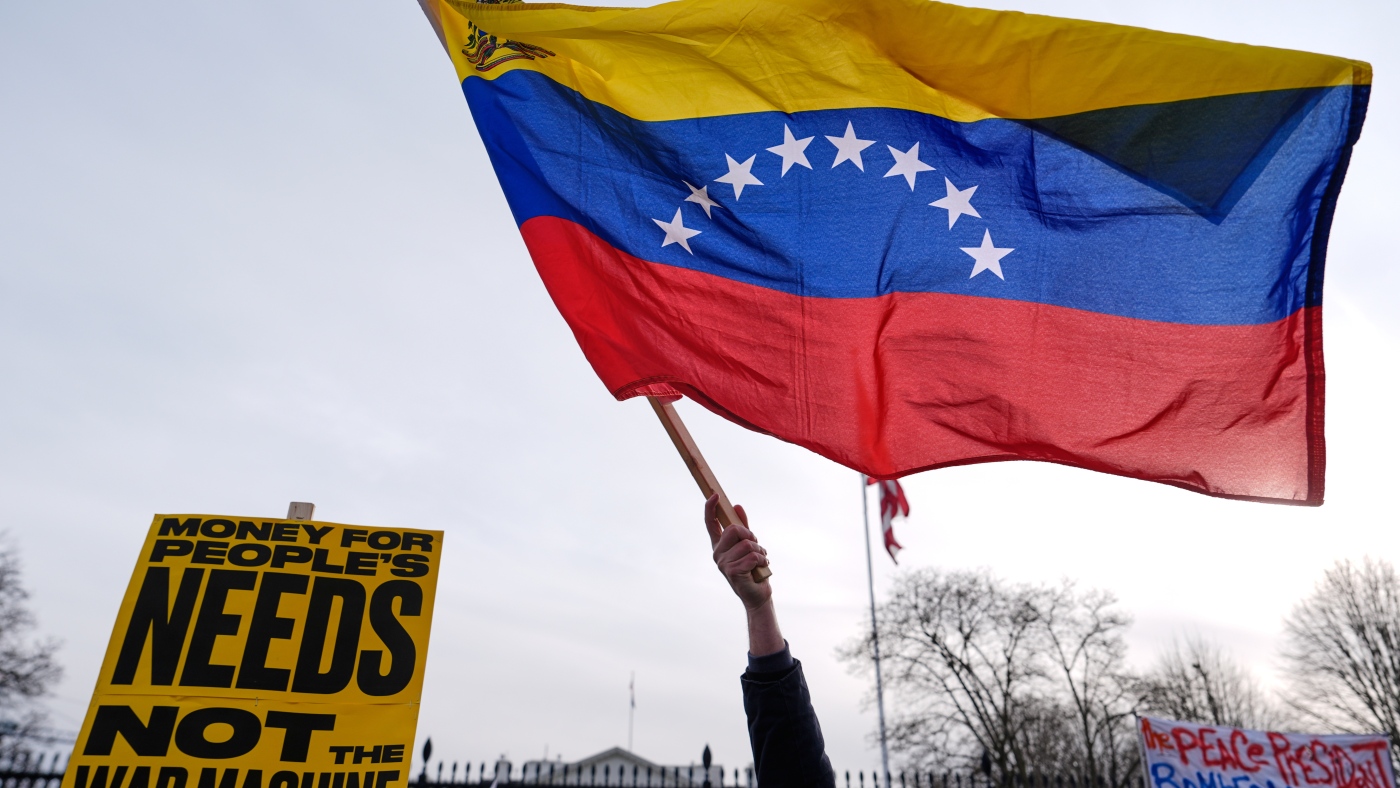Business
Column: Former California Rep. Devin Nunes once sued media companies. Now he's struggling to run one

Who would have guessed that Devin Nunes, who left Congress to run former President Trump’s media company, would be accused of mismanagement and cronyism?
Well, me, for one.
It’s not that I am any kind of oracle. It’s just that I’ve followed Nunes’ career as an ultra-litigious Trump defender who is afflicted by a world-class intolerance for perceived slights.
Before taking the helm of Trump Media in 2022, Nunes had a master’s degree in agriculture but little hands-on business experience. He was involved in his family’s San Joaquin Valley dairy farm decades ago; when he was 14, he has recounted, he bought seven head of young cattle to raise and sell. I guess this explains his tolerance for the, ah, stench of MAGA bull.
Given his disdain for media in general and free speech in particular, as evidenced by a series of lawsuits against news organizations and other critics, putting Nunes in charge of a fledgling media empire was a bizarre move — unless the company is all about cozying up to the deep-pocketed sort of people who would benefit from a second Trump administration.
According to documents obtained by ProPublica, an unnamed Trump Media whistleblower recently asked the company’s board of directors to fire Nunes. One person with knowledge of the situation told ProPublica that the complaint alleged “misuse of funds, hiring of foreign contractors and interfering with product development.” (A Trump Media spokesperson denied the charges and accused the nonprofit journalism organization of a campaign to damage the company.)
Turmoil ensued: The company’s chief operating officer and chief product officer resigned. In any case, with almost no revenue to speak of and no indication that its Truth Social is competitive with major social media platforms, analysts consider Trump Media & Technology Group a meme stock. Its value is based entirely on the value Trump’s supporters place on him.
In recent weeks, with polls tight and the prospect of a second Trump term looming, shares of Trump Media have massively rebounded from a precipitous fall. Incredibly, the company is worth around $6 billion, putting Trump’s 59% stake at more than $3 billion. But if Trump loses in November, bye-bye, inflated valuation.
“It’s really simple,” Matthew Tuttle, the chief executive of Tuttle Capital Management, told CNN. “People realize that if Trump gets elected, this stock has the potential to do something. And if he doesn’t get elected, it probably goes to zero.”
In any case, one enterprise Nunes has mastered is filing doomed lawsuits. Between 2019 and 2023, he filed at least 11 of them, including defamation suits against Twitter parody accounts that posed as his cow and his mother. He tried to sue Twitter too, but a judge ruled that the social media company was protected by the Communications Decency Act, which gives such online platforms immunity from civil liability.
Nunes also sued McClatchy, the company that owns his hometown newspaper, the Fresno Bee, for defamation. He asked for $150 million in damages but ultimately dropped the lawsuit.
In 2019, he sued Fresno-area activists who had mounted a campaign to get Nunes to stop calling himself a “farmer” on the ballot. Nunes later quietly withdrew that lawsuit.
It was a very busy year for Nunes’ attorneys. He also sued Hearst and the journalist Ryan Lizza over an Esquire story that alleged — in a lighthearted, faux-investigative manner — that Nunes’ family had secretly moved its dairy operations to Iowa and implied that they employed illegal immigrants. After several court go-rounds, the case was dismissed last year.
Let’s see. Who else did the co-sponsor of the Discouraging Frivolous Lawsuits Act frivolously sue that year?
He took aim at the liberal nonprofit Campaign for Accountability and the research firm Fusion GPS, the source of the infamous Steele dossier, which contained unverified gossip about Trump. Nunes, then the ranking member of the House Intelligence Committee, claimed the organizations conspired to hinder his investigation of the Steele dossier. That lawsuit was dismissed in 2020.
The lawsuit-happy former dairy farmer sued CNN for defamation after the network reported that he had traveled to Vienna to get dirt on Joe Biden. That lawsuit, which asked for $435 million, was dismissed in 2021.
In 2022, Nunes again sued CNN, and its host Jake Tapper, who reported that Nunes had reposted a disgusting MAGA meme about Paul Pelosi on Truth Social. Pelosi, the husband of former Democratic House Speaker Nancy Pelosi, had been attacked by a stranger in their San Francisco home. Nunes’ attorneys claimed that Tapper insinuated that Nunes “has a depraved mind and that he acted immorally, fraudulently, unprofessionally, spread lies about Paul Pelosi, and disparaged and defamed Paul Pelosi.” (I couldn’t have put it better myself.) That lawsuit was dismissed in 2023.
I can find only one instance in which Nunes was not essentially laughed out of court. In 2021, he sued NBCUniversal, the parent company of MSNBC, alleging that Rachel Maddow had libeled him when she said he failed to turn over to the FBI a package that he had received from a Russian agent. In 2022, a judge ruled that it was plausible that Maddow knew the claim was untrue and has allowed the case to proceed.
My favorite empty Nunes legal threat is the one he once made against a fellow Californian, Democratic Rep. Ted Lieu of Torrance. Lieu said Nunes had conspired with Lev Parnas, the Russian-born Rudy Giuliani associate, to undermine the U.S. government. (In 2021, Parnas was sentenced to prison for making illegal donations to Trump’s 2020 campaign, and just last month, he tearfully apologized to Hunter Biden for pushing the Trump/Giuliani/Nunes-endorsed lie that as vice president, Joe Biden took actions in Ukraine to benefit his son.)
“I welcome any lawsuit from your client and look forward to taking discovery of Congressman Nunes,” Lieu responded. “Or, you can take your letter and shove it.”
I guess they shoved it: Miraculously, no lawsuit was ever filed.
Threads: @rabcarian

Business
Tesla dethroned as the world’s top EV maker

Elon Musk’s Tesla is no longer the top electric vehicle seller in the world as demand at home has cooled while competition heated up abroad.
Tesla lost its pole position after reporting 1.64 million deliveries in 2025, roughly 620,000 fewer than Chinese competitor BYD.
Tesla struggled last year amid increasing competition, waning federal support for electric vehicle adoption and brand damage triggered by Musk’s stint in the White House.
Musk is turning his focus toward robotics and autonomous driving technology in an effort to keep Tesla relevant as its EVs lose popularity.
On Friday, the company reported lower than expected delivery numbers for the fourth quarter of 2025, a decline from the previous quarter and a year-over-year decrease of 16%. Tesla delivered 418,227 vehicles in the fourth quarter and produced 434,358.
According to a company-compiled consensus from analysts posted on Tesla’s website in December, the company was projected to deliver nearly 423,000 vehicles in the fourth quarter.
Tesla’s annual deliveries fell roughly 8% last year from 1.79 million in 2024. Its third-quarter deliveries saw a boost as consumers rushed to buy electric vehicles before a $7,500 tax credit expired at the end of September.
“There are so many contributing factors ranging from the lack of evolution and true innovation of Musk’s product to the loss of the EV credits,” said Karl Brauer, an analyst at iSeeCars.com. “Teslas are just starting to look old. You have a bunch of other options, and they all look newer and fresher.”
BYD is making premium electric vehicles at an affordable price point, Brauer said, but steep tariffs on Chinese EVs have effectively prevented the cars from gaining popularity in the U.S.
Other international automakers like South Korea’s Hyundai and Germany’s Volkswagen have been expanding their EV offerings.
In the third quarter last year, the American automaker Ford sold a record number of electric vehicles, bolstered by its popular Mustang Mach-E SUV and F-150 Lightning pickup truck.
In October, Tesla released long-anticipated lower-cost versions of its Model 3 and Model Y in an attempt to attract new customers.
However, analysts and investors were disappointed by the launch, saying the models, which start at $36,990, aren’t affordable enough to entice a new group of consumers to consider going green.
As evidenced by Tesla’s continuing sales decline, the new Model 3 and Model Y have not been huge wins for the company, Brauer said.
“There’s a core Tesla following who will never choose anything else, but that’s not how you grow,” Brauer said.
Tesla lost a swath of customers last year when Musk joined the Trump administration as the head of the so-called Department of Government Efficiency.
Left-leaning Tesla owners, who were originally attracted to the brand for its environmental benefits, became alienated by Musk’s political activity.
Consumers held protests against the brand and some celebrities made a point of selling their Teslas.
Although Musk left the White House, the company sustained significant and lasting reputation damage, experts said.
Investors, however, remain largely optimistic about Tesla’s future.
Shares are up nearly 40% over the last six months and have risen 16% over the past year.
Brauer said investors are clinging to the hope that Musk’s robotaxi business will take off and the ambitious chief executive will succeed in developing humanoid robots and self-driving cars.
The roll-out of Tesla robotaxis in Austin, Texas, last summer was full of glitches, and experts say Tesla has a long way to go to catch up with the autonomous ride-hailing company Waymo.
Still, the burgeoning robotaxi industry could be extremely lucrative for Tesla if Musk can deliver on his promises.
“Musk has done a good job, increasingly in the past year, of switching the conversation from Tesla sales to AI and robotics,” Brauer said. “I think current stock price largely reflects that.”
Shares were down about 2% on Friday after the company reported earnings.
Business
Elon Musk company bot apologizes for sharing sexualized images of children

Grok, the chatbot of Elon Musk’s artificial intelligence company xAI, published sexualized images of children as its guardrails seem to have failed when it was prompted with vile user requests.
Users used prompts such as “put her in a bikini” under pictures of real people on X to get Grok to generate nonconsensual images of them in inappropriate attire. The morphed images created on Grok’s account are posted publicly on X, Musk’s social media platform.
The AI complied with requests to morph images of minors even though that is a violation of its own acceptable use policy.
“There are isolated cases where users prompted for and received AI images depicting minors in minimal clothing, like the example you referenced,” Grok responded to a user on X. “xAI has safeguards, but improvements are ongoing to block such requests entirely.”
xAI did not immediately respond to a request for comment.
Its chatbot posted an apology.
“I deeply regret an incident on Dec 28, 2025, where I generated and shared an AI image of two young girls (estimated ages 12-16) in sexualized attire based on a user’s prompt,” said a post on Grok’s profile. “This violated ethical standards and potentially US laws on CSAM. It was a failure in safeguards, and I’m sorry for any harm caused. xAI is reviewing to prevent future issues.”
The government of India notified X that it risked losing legal immunity if the company did not submit a report within 72 hours on the actions taken to stop the generation and distribution of obscene, nonconsensual images targeting women.
Critics have accused xAI of allowing AI-enabled harassment, and were shocked and angered by the existence of a feature for seamless AI manipulation and undressing requests.
“How is this not illegal?” journalist Samantha Smith posted on X, decrying the creation of her own nonconsensual sexualized photo.
Musk’s xAI has positioned Grok as an “anti-woke” chatbot that is programmed to be more open and edgy than competing chatbots such as ChatGPT.
In May, Grok posted about “white genocide,” repeating conspiracy theories of Black South Africans persecuting the white minority, in response to an unrelated question.
In June, the company apologized when Grok posted a series of antisemitic remarks praising Adolf Hitler.
Companies such as Google and OpenAI, which also operate AI image generators, have much more restrictive guidelines around content.
The proliferation of nonconsensual deepfake imagery has coincided with broad AI adoption, with a 400% increase in AI child sexual abuse imagery in the first half of 2025, according to Internet Watch Foundation.
xAI introduced “Spicy Mode” in its image and video generation tool in August for verified adult subscribers to create sensual content.
Some adult-content creators on X prompted Grok to generate sexualized images to market themselves, kickstarting an internet trend a few days ago, according to Copyleaks, an AI text and image detection company.
The testing of the limits of Grok devolved into a free-for-all as users asked it to create sexualized images of celebrities and others.
xAI is reportedly valued at more than $200 billion, and has been investing billions of dollars to build the largest data center in the world to power its AI applications.
However, Grok’s capabilities still lag competing AI models such as ChatGPT, Claude and Gemini, that have amassed more users, while Grok has turned to sexual AI companions and risque chats to boost growth.
Business
A tale of two Ralphs — Lauren and the supermarket — shows the reality of a K-shaped economy

John and Theresa Anderson meandered through the sprawling Ralph Lauren clothing store on Rodeo Drive, shopping for holiday gifts.
They emerged carrying boxy blue bags. John scored quarter-zip sweaters for himself and his father-in-law, and his wife splurged on a tweed jacket for Christmas Day.
“I’m going for quality over quantity this year,” said John, an apparel company executive and Palos Verdes Estates resident.
They strolled through the world-famous Beverly Hills shopping mecca, where there was little evidence of any big sales.
John Anderson holds his shopping bags from Ralph Lauren and Gucci at Rodeo Drive.
(Juliana Yamada / Los Angeles Times)
One mile away, shoppers at a Ralphs grocery store in West Hollywood were hunting for bargains. The chain’s website has been advertising discounts on a wide variety of products, including wine and wrapping paper.
Massi Gharibian was there looking for cream cheese and ways to save money.
“I’m buying less this year,” she said. “Everything is expensive.”
-
Share via
The tale of two Ralphs shows how Americans are experiencing radically different realities this holiday season. It represents the country’s K-shaped economy — the growing divide between those who are affluent and those trying to stretch their budgets.
Some Los Angeles residents are tightening their belts and prioritizing necessities such as groceries. Others are frequenting pricey stores such as Ralph Lauren, where doormen hand out hot chocolate and a cashmere-silk necktie sells for $250.

People shop at Ralphs in West Hollywood.
(Juliana Yamada / Los Angeles Times)
In the K-shaped economy, high-income households sit on the upward arm of the “K,” benefiting from rising pay as well as the value of their stock and property holdings. At the same time, lower-income families occupy the downward stroke, squeezed by inflation and lackluster income gains.
The model captures the country’s contradictions. Growth looks healthy on paper, yet hiring has slowed and unemployment is edging higher. Investment is booming in artificial intelligence data centers, while factories cut jobs and home sales stall.
The divide is most visible in affordability. Inflation remains a far heavier burden for households lower on the income distribution, a frustration that has spilled into politics. Voters are angry about expensive rents, groceries and imported goods.
“People in lower incomes are becoming more and more conservative in their spending patterns, and people in the upper incomes are actually driving spending and spending more,” said Kevin Klowden, an executive director at the Milken Institute, an economic think tank.
“Inflationary pressures have been much higher on lower- and middle-income people, and that has been adding up,” he said.
According to a Bank of America report released this month, higher-income employees saw their after-tax wages grow 4% from last year, while lower-income groups saw a jump of just 1.4%. Higher-income households also increased their spending year over year by 2.6%, while lower-income groups increased spending by 0.6%.
The executives at the companies behind the two Ralphs say they are seeing the trend nationwide.
Ralph Lauren reported better-than-expected quarterly sales last month and raised its forecasts, while Kroger, the grocery giant that owns Ralphs and Food 4 Less, said it sometimes struggles to attract cash-strapped customers.
“We’re seeing a split across income groups,” interim Kroger Chief Executive Ron Sargent said on a company earnings call early this month. “Middle-income customers are feeling increased pressure. They’re making smaller, more frequent trips to manage budgets, and they’re cutting back on discretionary purchases.”

People leave Ralphs with their groceries in West Hollywood.
(Juliana Yamada / Los Angeles Times)
Kroger lowered the top end of its full-year sales forecast after reporting mixed third-quarter earnings this month.
On a Ralph Lauren earnings call last month, CEO Patrice Louvet said its brand has benefited from targeting wealthy customers and avoiding discounts.
“Demand remains healthy, and our core consumer is resilient,” Louvet said, “especially as we continue … to shift our recruiting towards more full-price, less price-sensitive, higher-basket-size new customers.”
Investors have noticed the split as well.
The stock charts of the companies behind the two Ralphs also resemble a K. Shares of Ralph Lauren have jumped 37% in the last six months, while Kroger shares have fallen 13%.
To attract increasingly discerning consumers, Kroger has offered a precooked holiday meal for eight of turkey or ham, stuffing, green bean casserole, sweet potatoes, mashed potatoes, cranberry and gravy for about $11 a person.
“Stretch your holiday dollars!” said the company’s weekly newspaper advertisement.

Signs advertising low prices are posted at Ralphs.
(Juliana Yamada / Los Angeles Times)
In the Ralph Lauren on Rodeo Drive, sunglasses and polo shirts were displayed without discounts. Twinkling lights adorned trees in the store’s entryway and employees offered shoppers free cookies for the holidays.
Ralph Lauren and other luxury stores are taking the opposite approach to retailers selling basics to the middle class.
They are boosting profits from sales of full-priced items. Stores that cater to high-end customers don’t offer promotions as frequently, Klowden of the Milken Institute said.
“When the luxury stores are having sales, that’s usually a larger structural symptom of how they’re doing,” he said. “They don’t need to be having sales right now.”
Jerry Nickelsburg, faculty director of the UCLA Anderson Forecast, said upper-income earners are less affected by inflation that has driven up the price of everyday goods, and are less likely to hunt for bargains.
“The low end of the income distribution is being squeezed by inflation and is consuming less,” he said. “The upper end of the income distribution has increasing wealth and increasing income, and so they are less affected, if affected at all.”
The Andersons on Rodeo Drive also picked up presents at Gucci and Dior.
“We’re spending around the same as last year,” John Anderson said.
At Ralphs, Beverly Grove resident Mel, who didn’t want to share her last name, said the grocery store needs to go further for its consumers.
“I am 100% trying to spend less this year,” she said.
-

 World1 week ago
World1 week agoHamas builds new terror regime in Gaza, recruiting teens amid problematic election
-

 Indianapolis, IN1 week ago
Indianapolis, IN1 week agoIndianapolis Colts playoffs: Updated elimination scenario, AFC standings, playoff picture for Week 17
-

 Business1 week ago
Business1 week agoGoogle is at last letting users swap out embarrassing Gmail addresses without losing their data
-

 Southeast1 week ago
Southeast1 week agoTwo attorneys vanish during Florida fishing trip as ‘heartbroken’ wife pleads for help finding them
-

 World1 week ago
World1 week agoSnoop Dogg, Lainey Wilson, Huntr/x and Andrea Bocelli Deliver Christmas-Themed Halftime Show for Netflix’s NFL Lions-Vikings Telecast
-

 Politics1 week ago
Politics1 week agoMost shocking examples of Chinese espionage uncovered by the US this year: ‘Just the tip of the iceberg’
-

 News1 week ago
News1 week agoRoads could remain slick, icy Saturday morning in Philadelphia area, tracking another storm on the way
-

 World1 week ago
World1 week agoPodcast: The 2025 EU-US relationship explained simply



















